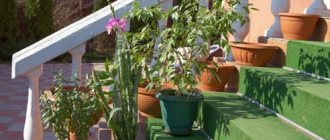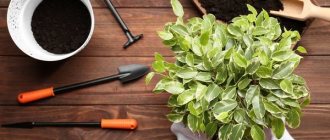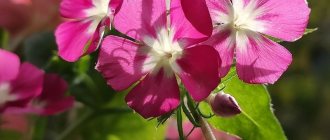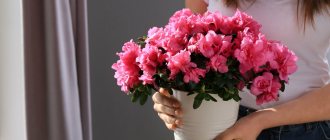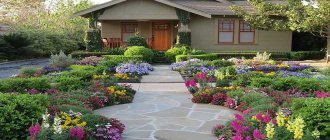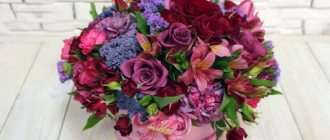Live cut flowers are inferior to preserved flowers in many respects. They are beautiful, but their life in a vase with water is fleeting. Stabilized ones are superior to freshly cut ones and have a number of advantages:
- They do not lose their spectacular appearance for several months and even years.
- They do not emit harmful substances into the atmosphere.
- Suitable for placement in rooms where allergy sufferers live. Such flowers are devoid of pollen and therefore do not cause allergic reactions.
- They are easy to care for and do not collect dust.
- Versatility in use, plenty of scope for creating fancy phyto-compositions.
Using a preservative is a great way for those wondering how to preserve flowers given for a special occasion. For example, roses given for a wedding will delight and remind you of the special event until the anniversary.
What flowers can be stabilized
Not all plants can be embalmed. Only specimens with dense stems are suitable. Designer bouquets are made of roses, peonies, orchids, gardenias, chrysanthemums, and gerberas. Moss is used for vertical decoration.
Preserved moss wall
With the help of dyes it is painted in the most unusual colors.
Herbs and leaves are woven into the composition:
- eucalyptus;
- bergrass;
- fern;
- palm leaf;
- papyrus;
- lavender;
- largus;
- pampas grass.
Small ornamental trees are actively stabilized. They are installed in rooms, halls, greenhouses, and winter gardens. This is orange, myrtle, lemon.
How can you use preserved flowers?
Typically, compositions and bouquets using preserved flowers are collected to order and addressed to a specific person. In this case, florists find out the recipient’s preferences in plants, colors, and size.
Stabilized compositions are given as gifts instead of ordinary bouquets, and are created for celebrations and events, as well as for interior decoration.
Use of stabilized plants
Designer composition using stabilized plants
Professional florists and phyto-designers use flowers stabilized in a professional manner under industrial production conditions.
They create spectacular compositions, miniature paintings and entire panels.
Vertical wall decoration with moss and flowers is a modern trend in interior design.
Wall composition made of stabilized moss
Green panels bring an element of living nature into the interior and look stylish and elegant.
Stabilized plants are actively used in the design of wedding banquets, motorcades, and become decor for the hairstyle and even the bride’s outfit.
Preserved shrubs and miniature trees are installed in congress halls and used to decorate shop windows and greenhouses.
Flowers, branches, grass and leaves
Decorative flowering plants and delicate twigs are woven into a single composition that can become a gift for a special occasion. Such miniature bouquets are often placed on tables in European restaurants.
Flowers for the festive table
At home, a composition of herbs and flowers will help diversify and decorate the interior. These can be bouquets of several roses. A complex version with the inclusion of leaves of a domestic palm tree or branches of an ornamental shrub is also suitable.
Trees
Small trees are also amenable to the stabilization process, but it takes longer than in the case of flowers.
Preserved trees look like living ones and retain the freshness of their crowns for up to 15-20 years. A tree installed indoors does not require special care and does not need to be watered. Bonsai are very popular. To grow and maintain the shape of such a tree, gardeners have to work hard, but a stabilized bonsai will not require any care.
Mosses
Wall composition of stabilized plants
Due to its peculiarity, moss looks luxurious in small panels and large wall installations. They are increasingly used to decorate the interiors of offices, restaurants, and public institutions. Stabilized moss retains its structure perfectly.
It retains its natural color well even after the canning process, and the ability to paint it in different colors expands the space for implementing the most unusual design ideas.
Design solutions using stabilized moss
Compositions of stabilized flowers
Unfading plants are used in interior design of houses, apartments, catering establishments, and banquet halls.
You can try to create a stabilized flower yourself and place it in a vase at home.
Designer bouquet
Bouquets of embalmed flowers at home are environmentally friendly, do not require special care, and remain fresh for a long time. Stabilized roses are very popular. They go well in combinations with other plants and look impressive in mono bouquets. Good to read: An important part of every bouquet is the details.
Stabilized flowers in a flask
Present.
Photo from pixabay.com This souvenir will be a wonderful gift for any occasion. A rose in a flask can be presented to a loved one or manager.
Making such a souvenir yourself is not difficult, but it will take time. The master class looks like this step by step:
- stabilize the flower;
- make a hole in the wooden stand;
- secure the stem with a nail;
- cover the rose with a flask.
A composition of stabilized flowers can include not only one rose, but also herbs and other flowering crops.
Flower arrangement - table decoration
Paintings from stabilized flowers
If you embalm different plants and give them bright colors, you can make a panel with your own hands.
The basis of the picture is a cardboard or wooden base on which flowers and herbs are attached. Before making stabilized flowers, prepare the base and baguette. The panel can be placed under glass or left without it - the plants will look good in any form. Phyto-designers decorate entire walls and display cases using embalmed cultures.
Moss is most often used; it retains its texture and rich colors for a long time.
Stabilized moss in the interior. Video
Wreath of preserved flowers
Moss and unfading flowers will serve as materials for creating an elegant piece of decor, for example, in a New Year's style. You will need a base in the form of a circle. It can be made of cardboard, wood or foam. The plants are attached using a glue gun, the composition is decorated with ribbons, beads, and New Year's attributes.
Preserved flowers in a pot
The interior composition can be decorated in a beautiful pot or flowerpot. Stabilized roses of different sizes, eucalyptus branches, moss, and herbs are suitable for it. A spongy material is placed at the bottom of the container into which the plants are inserted.
Choose a shallow pot or container so that the composition, rather than its body, attracts the eye.
Flower arrangement in a pot
Stabilized flowers in a glass pot look impressive. Florariums fit perfectly into the interior of a variety of rooms.
Various design options for stabilized colors
Various compositions and bouquets are collected from stabilized flowers, florariums, combining roses, hydrangeas, carnations, eucalyptus, dried flowers and cotton branches are added.
Each composition is assembled entirely by hand. Many florists use cardboard, wooden boxes, vases and flowerpots made of glass, plaster and ceramics, hat boxes, film, fabric to collect a unique bouquet.
How to prepare plants for preservation
In industrial production, roses and other plants are kept in sealed containers for a certain time and only after that they begin to stabilize.
Before embalming begins, the plants are cleaned of pollen and contaminants, the stems are trimmed, and dried for several hours.
The production facilities have the necessary equipment, and the solution formulas are more complex than the options that are prepared for home use. Therefore, not all plants will be able to be embalmed on their own. Roses are best suited for this experiment. They have a dense flexible stem, and the petals, after stabilization, remain tender and retain the elasticity of the tissue.
How to care for stabilized flowers
Flowers that have undergone stabilization do not like moisture and sun. They should be stored in dry rooms with light partial shade or simply away from the window. You should not place stabilized flowers in saunas and baths, otherwise high humidity will shorten their life.
If you need to clean the flowers from dust, you can use a hairdryer with a cold stream of air or wipe the plants with a dry sponge.
Stabilized flowers do not need to be subjected to any other procedures ; they stand well in dry flowerpots or plant pots, wooden boxes or hat boxes using dry floral sponges.
Industrial options for stabilizing flower arrangements
The process is based on the ability of glycerin to nourish the plant and not evaporate.
Pure glycerin is not suitable for high-quality creation of timeless flowers. It will simply draw out all the vital juices from the stem.
Those who first heard what stabilized flowers are and want to try to preserve a purchased wild rose or gerbera at home will have to study the features of embalming.
In production, solutions are prepared taking into account various features.
The plant must receive moisture, so glycerin is diluted with water. Alcohols, acetone, and preservatives are added to the composition.
Dyes are actively used; they diversify the color palette and allow you to obtain flowers with an unusual shade. To ensure that the composition is not only effective, but also exudes a pleasant aroma, flavoring compounds are used.
Tips for stabilizing plants
To keep the bouquet truly fresh and beautiful, you need to follow these rules:
- Use only fresh plants. The more time passes from the moment the flowers are cut, the more difficult it will be to preserve them.
- Tint flowers with food coloring. During the stabilization process, the color of the buds in the bouquet fades. To make it brighter, you need to add food coloring of the desired color to the solution. By the way, white flowers can be painted in any color in this way.
- Do not leave preserved flowers in the sun or in rooms with high humidity. This will quickly destroy them.
Use these recipes to extend the life of your flowers! You can order vertical gardening from us at an affordable price.
Other preservation methods
At home, stabilization methods are available with compositions of glycerin diluted with water in different concentrations.
- Prepare a solution from equal parts of glycerin and water.
- Dip the prepared plant into the liquid completely or to the base of the bud.
- After a week, the solution is replaced with a fresh one.
- Every 5-7 days, the flower is removed and the cut is trimmed - this will speed up the process of penetration of the composition into the tissue.
A sign that stabilization has completed will be droplets of moisture on the petals.
The embalmed flowers are taken out and hung with the bud down to drain the liquid. Now you can use them to create compositions.
How to preserve flowers with wax
Another method available at home is flowers stabilized with paraffin. It does not require as much time as stabilization with glycerin, but requires dexterity, which is acquired with experience.
Cosmetic paraffin can be purchased at a specialty store. Before starting the process, the wax should be melted in a water bath and cool slightly.
Turn the rose upside down, dip it in liquid paraffin for a minute and remove it. After 2-3 minutes, repeat the dip and remove from the wax again. The number of dives is 4-5 for each flower.
The paraffin hardens and seals each petal. At the same time, the brightness of the bud will not fade.
A stabilized rose will last for several months. If desired, the bud can be painted by spraying paint from a spray bottle or painted with a thin brush.
What is this
Stabilization is a method when plant juices are replaced with preservation solutions prepared using a special technology. They inhibit the processes of withering and cell breakdown. Glycerin, wax, and gelatin are often used to prepare solutions. However, there are other stabilization methods.
The solutions are used to saturate the entire body of the plant - stem, leaves, flowers. As a result of saturation of fabrics, texture, shape and “look” are preserved. The petals and leaves of flowers that have undergone stabilization are, as a rule, as soft and elastic as those of freshly picked counterparts.
Most often, the stabilizing solution makes the natural color and aroma of the inflorescences less bright. They are restored with the help of aromatic oils and special coloring agents.
The technology for preserving flowers, which has turned into a new trend in floristry, was developed by Jeanette and Paul Lambert, a Belgian and French woman who tied the knot. In the 70s of the 20th century, the couple moved to Kenya, where they founded their own floristic house, Vermont.
Jeannette and Paul have shortened the period of delivery of plants from the plantations to the workshops: at the initial stage, the buds that have blossomed are cut and sorted, and smooth, dense-leaved plants without flaws are selected. Then the flowers are sent to production, where workers preserve them. Specialists ensure that the technology stages are not violated.
Florists widely use preserved flowers. They decorate banquet halls, restaurants and cafes, shopping areas, hotel lobbies, etc. with them. Stabilized plants are used to create interior compositions; they look great on gift packages. Flowers that have undergone stabilization methods do not need to be watered, illuminated in a special way, or replanted.
Composition in a glass vessel
An excellent method that is suitable for preserving both individual flowers and compositions or small bushes. Bouquets in an original transparent glass jar can decorate your home or be a good birthday gift. Hand-made is in fashion now!
Before you start canning, you need to sterilize the vessel where the plants will “live”. The jar should be held over steam for several minutes or doused with boiling water. This procedure is mandatory; it helps get rid of germs.
When the vessel is ready, you need to place the plants in it, forming a composition. Fantasy will come to the rescue. You can add twigs with openwork leaves or greenery to the flowers. Pebbles, shells, and beads are suitable as decoration - the main thing is that these small things are resistant to moisture.
Having laid out the composition, the jar is filled with solution. There are several recipes.
First . For preparation you will need glycerin. The substance must be diluted in a ratio of one to two - part glycerin to two parts drinking water. Pour the solution into a jar. After two days it needs to be changed.
Second . It is prepared as follows: sugar and gelatin are dissolved in equal proportions in water, and then left for several hours. Then the composition is heated on the stove, mixed well, and then filtered through cheesecloth and a fine sieve, getting rid of particles that have not dissolved.
Third . A saturated saline solution is also suitable for preserving flowers in a jar.
No matter what composition you choose, do not forget to distribute the flowers harmoniously so that the composition looks neat. When drowning in liquid, plants should not come into contact with each other. Close the container with a lid. It can be decorated with ribbon or twine. The composition is ready!
Advantages of canning:
- bouquets in jars look very advantageous and original;
- plants floating in the solution retain an attractive appearance for a long time;
- conservation technology is simple and does not take much time.
Disadvantages of jar preservation : flowers can only be seen through the glass of the vessel; plants cannot be taken out.

